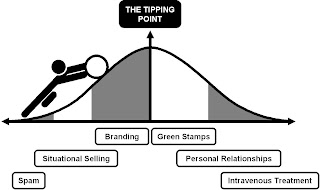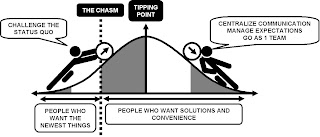Because they share basic insights of Evrett Rogers, Goeffrey Moore, Seth Godin and Malcolm Gladwell! So here is my small manifesto for less academic mumbo jumbo and more marketing common sense.
Population Analysis
For starters, in a 1962 book called Diffusion of Innovations, Everett Rogers (*) stated that adopters of any new innovation or idea could be categorized on a classic bell-shaped curve as described here:
- Innovators (2.5 %) Venturesome, educated, multiple information sources, greater propensity to take risk
- Early Adopters (13.5%) Social leaders, popular, educated
- Early Majority (34%) Deliberate, many informal social contacts
- Late Majority (34%) Skeptical, traditional, lower socio-economic status
- Laggards (16%) Neighbors and friends are main information sources, fear of debt
 Building further on Rogers’ observations, Geoffrey Moore’s (**) key insight is that the groups adopt innovations for different reasons. According to Moore, early adopters are technology enthusiasts looking for a radical shift, while the early majority wants a productivity improvement. Both groups are divided by a chasm.
Building further on Rogers’ observations, Geoffrey Moore’s (**) key insight is that the groups adopt innovations for different reasons. According to Moore, early adopters are technology enthusiasts looking for a radical shift, while the early majority wants a productivity improvement. Both groups are divided by a chasm.
Moore’s observations come close to what you can expect when introducing a shift inside your organization, be it a new performance evaluation system, new software or simply moving from one building to another. According to Moore:
- Technology Enthusiasts (Innovators) are explorers.
- Visionaries (Early Adopters) are more geared towards exploitation. They are not especially bothered by the fact that the product doesn’t work. They are willing to make it work.
- Pragmatists (Early Majority) want a product that works. They want a 100% solution to their business problem. If they get the 80 % that delighted the visionary, they feel cheated, and they tell their pragmatist friends.
- Conservatives (Late Majority) buy products because they really have no choice. They are not reassured by having books about the product,because the existence of books implies the product isn’t simple enough to use. Conservatives will not tolerate complexity.
- Skeptics (Laggards) are not going to buy, though they may talk other people out of buying.
The problem in crossing the chasm is that the visionaries aren’t good references for the pragmatists. They provide tales of heroics. Pragmatists want references from other pragmatists. This brings us to the basic insight that it is going to take strong marketing and employee relationship management (i. e., customer relationship management from the implementation team towards the organization) in order to reach the majority.
Lessons from Customer Relationship Management
Customer relationship management (CRM) is the art of building learning relationships with your target public. In practice we often find a lack of interest when it comes to building a learning relationship between the implementation team and the organization. CRM tells us how to do that if we are willing to replace the “c”of customer with the “e” of employee.
Seth Godin (***), one of the pioneers of CRM, introduced the concept of Permission Marketing in 1999. The list below mentions the six levels of permission that can depict the relationship with a customer, according to Godin.

- Intravenous Treatment The doctor treating you in the emergency room doesn’t have to sell you very hard on administering a drug.
- Green Stamps Executives suffer through long layovers to gain frequent-flyer miles. Here, the company rewards customers in currency they care about.
- Personal Relationships The corner dry cleaner enjoys implicit permission to act in your best interest. A favorite retailer can “upscale” you (recommend something more expensive) without offending you.
- Branding Given a choice between the known and the unknown, most people choose the known.
- Situational Selling If you’re in a store and you’re about to make a purchase, you often welcome unsolicited marketing advice.
- Spam Where most marketers live most of the time: calling a stranger at home, during dinner, without permission. You wouldn’t do it in your personal life. Why do it to potential customers?
Pushing and Pulling
The six levels of permission can help us to get more clarity about our position in relationship with the organization. It becomes even more interesting when we start weaving in the insights of Malcolm Gladwell (****), who investigated what determines the moment of critical mass, the threshold, or even the boiling point of a marketing effort. He calls it the Tipping Point.
From an organizational change point of view, the combination of Gladwell’s and Godin’s observations is illustrated in below: Starting an organizational change program may at times resemble pushing a boulder up a hill. You seem to be making an 80 % selling effort for barely a 20 % response. Your learning relationship with the organization hinges on the lower levels of permission, as you are in the beginning of a relationship. You will soon find out that as the permission level evolves, you will get the buy-in from pragmatists and conservatives.
Starting an organizational change program may at times resemble pushing a boulder up a hill. You seem to be making an 80 % selling effort for barely a 20 % response. Your learning relationship with the organization hinges on the lower levels of permission, as you are in the beginning of a relationship. You will soon find out that as the permission level evolves, you will get the buy-in from pragmatists and conservatives.
Before you know it, the boulder starts rolling as a result of the people going through the change cycle. Instead of you pushing a boulder alone, the organization is now pulling at your sleeves to move it forward. From now on, you will have to pace the majority of pragmatists and conservatives,who will be pressing you for concrete details.
Therefore, during your communication it is important that you set the right expectations and that you do not over-promise with regard to delivering prototypes and demonstrating solutions. It is painful to be applauded for the demonstration of a certain solution only to find out that you overlooked some important elements because you did not consult the implementation team at large. You must align solutions internally first before making promises to the organization. Minor and major incidents in this area will make you aware that you will need to centralize communication as you are approaching the date of delivery.
___________________
(*) Rogers, E.: Diffusion of Innovations, Free Press 1962
(**) Moore, G.A.: Crossing the Chasm: Marketing and Selling High-Tech Products to Mainstream Customers, HarperBusiness 1999
(***) Godin, S.: Permission Marketing. Simon & Schuster 1999
(****) Gladwell, M.: The Tipping Point. How Little Things Can Make a Big Difference,Little Brown 2000






Pingback: About Anchors | Reply-MC()